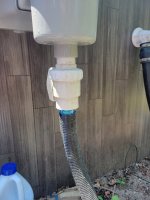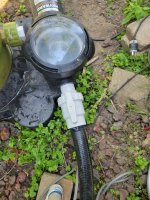Hi.
I've had a 24' above-ground pool now for a few years, and I'll never forget the day that I found TFP and the vast knowledge here, as that was when my completely-not-knowing-the-first-thing-about-pool-care rear got straightened out and haven't had problems since. So, hats off to this tremendous site!
For probably 2-3 years (that I can recall), I've noticed that I have a tendency to get air in my filtration circuit, and I'm not sure how or where it's getting in there. I can often open the air purge valve on the top of my filter housing and have it air out for a good 30 seconds before the water starts shooting out of it and close it.
It definitely has a tendency to do that when I connect the vacuum (just a simple Kontiki jammy with the little thing that goes in the skimmer basket that causes the "chugging" action), but even when it's not connected and we're just talking the pump running as a matter of routine.
The water level in the pool is definitely ample and sufficient, so there's no hiccups at the skimmer basket. I could definitely see how air would get in if it weren't.
I don't have any other wacky attachments to my circuit. Just skimmer basket --> pump --> filter --> return (photos included).
I am not noticing any water leaks anywhere, either.
If anyone has any insight as to how this might be happening or places to check or things that I could otherwise be doing to avoid or eliminate this, I'd be grateful.
Also, if this is normal behavior, it'd help me to know that, too!
Thank you all!! TFP rocks!
Jayson
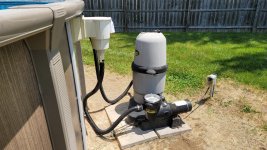
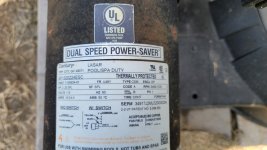
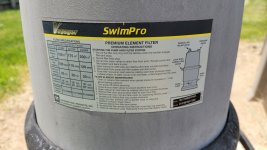
I've had a 24' above-ground pool now for a few years, and I'll never forget the day that I found TFP and the vast knowledge here, as that was when my completely-not-knowing-the-first-thing-about-pool-care rear got straightened out and haven't had problems since. So, hats off to this tremendous site!
For probably 2-3 years (that I can recall), I've noticed that I have a tendency to get air in my filtration circuit, and I'm not sure how or where it's getting in there. I can often open the air purge valve on the top of my filter housing and have it air out for a good 30 seconds before the water starts shooting out of it and close it.
It definitely has a tendency to do that when I connect the vacuum (just a simple Kontiki jammy with the little thing that goes in the skimmer basket that causes the "chugging" action), but even when it's not connected and we're just talking the pump running as a matter of routine.
The water level in the pool is definitely ample and sufficient, so there's no hiccups at the skimmer basket. I could definitely see how air would get in if it weren't.
I don't have any other wacky attachments to my circuit. Just skimmer basket --> pump --> filter --> return (photos included).
I am not noticing any water leaks anywhere, either.
If anyone has any insight as to how this might be happening or places to check or things that I could otherwise be doing to avoid or eliminate this, I'd be grateful.
Also, if this is normal behavior, it'd help me to know that, too!
Thank you all!! TFP rocks!
Jayson



Last edited by a moderator:


 , that's definitely not the issue, but I definitely appreciate your contributing.
, that's definitely not the issue, but I definitely appreciate your contributing.